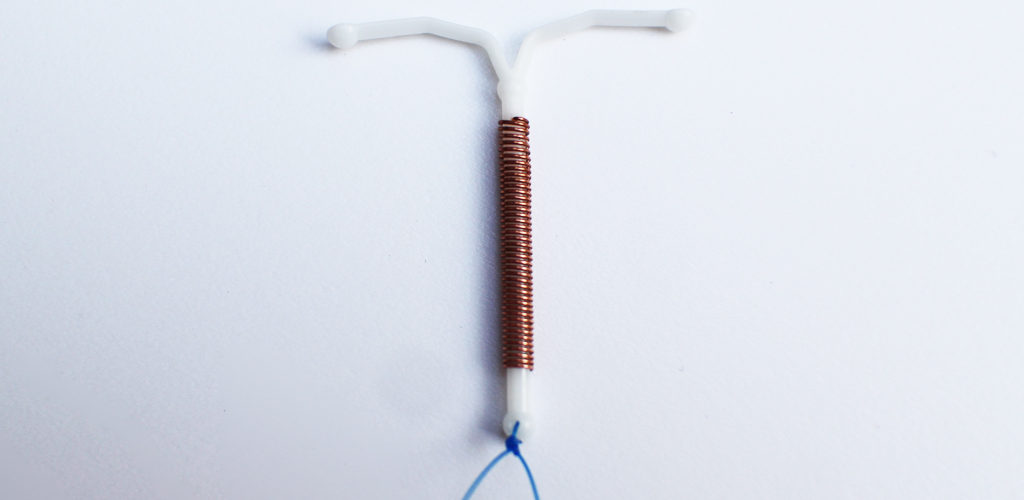Copper IUD
What is the copper IUD?
- The copper IUD (intra-uterine device) is a small, T-shaped piece of plastic that is wrapped with copper wire that a clinician inserts into your uterus.
- This page is about the copper IUD. For information on the hormonal IUD, see the hormonal IUD page [Link].
How does the copper IUD prevent pregnancy?
- In order to get pregnant, sperm must enter your vagina*, swim up into your uterus and fertilize an egg that has been released from your ovaries during ovulation. The combination of the IUD and the copper in your uterus changes the chemistry of the uterus and makes it hard for sperm and eggs to survive and meet.
- The copper IUD can be used as an emergency contraception to prevent pregnancy up to seven days after sperm has entered you body.
How effective is the copper IUD?
- The copper IUD is 99% effective. This means that if 100 people had the copper IUD in for one year, only one person would get pregnant.
How do you use the copper IUD?
- A clinician will insert the IUD into your uterus.
- The copper IUD looks like a plastic T with strings attached at the bottom. The plastic part stays in your uterus, and the strings hang outside your cervix (the opening of your uterus). These strings are short and will not hang outside your vagina. You can feel them if you put a finger into your vagina and touch your cervix, but the strings cannot not usually be felt with a penis.*
- It is normal for the strings to move around a bit or seem to change length. If you are curious, you can check your strings by feeling for them with your finger(s).
- You can have a copper IUD removed by a clinician whenever you are finished with it, or leave it in place for up to 3, 5 or 10 years depending on the model.
How to start using the copper IUD
- If you decide, along with your clinician, that the copper IUD is right for you, your clinician will write you a prescription. You can purchase your IUD at a pharmacy (approximately $80 – $350) or at a sexual health clinic that sells IUDs (approx. $50 – $175).
- PPT’s Health Services sells the 5 year copper IUD for $44.50 and the 10 year for $57.50 and inserts IUDs by appointment.
- Before you get a prescription, your clinician will need to do a complete pelvic exam and test you for infections, including some sexually transmitted infections (STIs).
- Your clinician may want to put in the IUD while you are on your period, but this is not always necessary.
- After insertion you may feel some discomfort and cramping. This usually goes away within a few days. You may want to discuss using pain medication with your clinician.
- You will be protected from pregnancy right away, but you may want to wait 48 hours before having vaginal sex. Your clinician may also recommend you use a back-up method of birth control like condoms or spermicides for the first 6 weeks.
What are the side effects of the copper IUD?
- You may have heavier periods.
- Menstrual (period) cramps may be more intense or uncomfortable.
Advantages of the copper IUD
- It can be used for up to 3, 5, or 10 years, depending on the model.
- You don’t have to do anything just before or after you have sex.
- It is a relatively “hands off” method. You only need to have a clinician check for your strings when you get a routine pelvic exam to make sure the IUD is in place.
- There are no hormonal side effects. People who can’t or do not want to take hormonal birth control can use this method.
- It doesn’t affect your ability to get pregnant in the future.
- You don’t have to rely on your partner(s) to use it.
- If you want to keep your birth control use private, there is no packaging to be found.
- Over the course of 5 or 10 years, the monthly cost of the IUD works out to be cheaper than other options like the pill or ring.
Disadvantages of the copper IUD
- A clinician must insert and remove the IUD. Insertion may be harder in people who have never given birth, but it is still possible.
- Insertion may be uncomfortable or painful.
- There is a very small chance that your IUD could break through the wall of your uterus while it is being inserted (fewer than 1 in 1000 insertions). Your uterus should heal if this happens.
- There is small chance your body could expel (push out) your IUD in the first year (2-10% of users). If you don’t feel this happen or don’t find the expelled IUD, you are at risk of pregnancy if you have vaginal sex. IUD expulsion is the most common in the first 6 weeks after insertion. Your clinician may recommend you use a back-up method of birth control like condoms or spermicides for the first 6 weeks.
- If your uterus expels the IUD and you would like another one inserted, you will have to pay for another IUD.
- If you have an STI or other infection when you have your IUD inserted, or if you get one within the first 3 weeks of having an IUD, you are at a slightly increased risk of developing pelvic inflammatory disease (PID). PID can be painful and can potentially lead to infertility. The risk of PID after 3 weeks is not significantly higher when compared to people without IUDs.
- Some clinicians may be hesitant to prescribe an IUD to people who have a higher perceived risk of STIs.
- You may experience side effects.
- It doesn’t protect you from STIs.
For a downloadable resource on this topic, please visit Planned Parenthood Toronto Factsheet Database.
If you have questions about this topic, feel free to contact one of our peer educators. [Link]
*We know that these aren’t the words everyone uses for their bodies (eg. trans folks), and support you using the language that feels best for you.
Last Edited: May 2020






